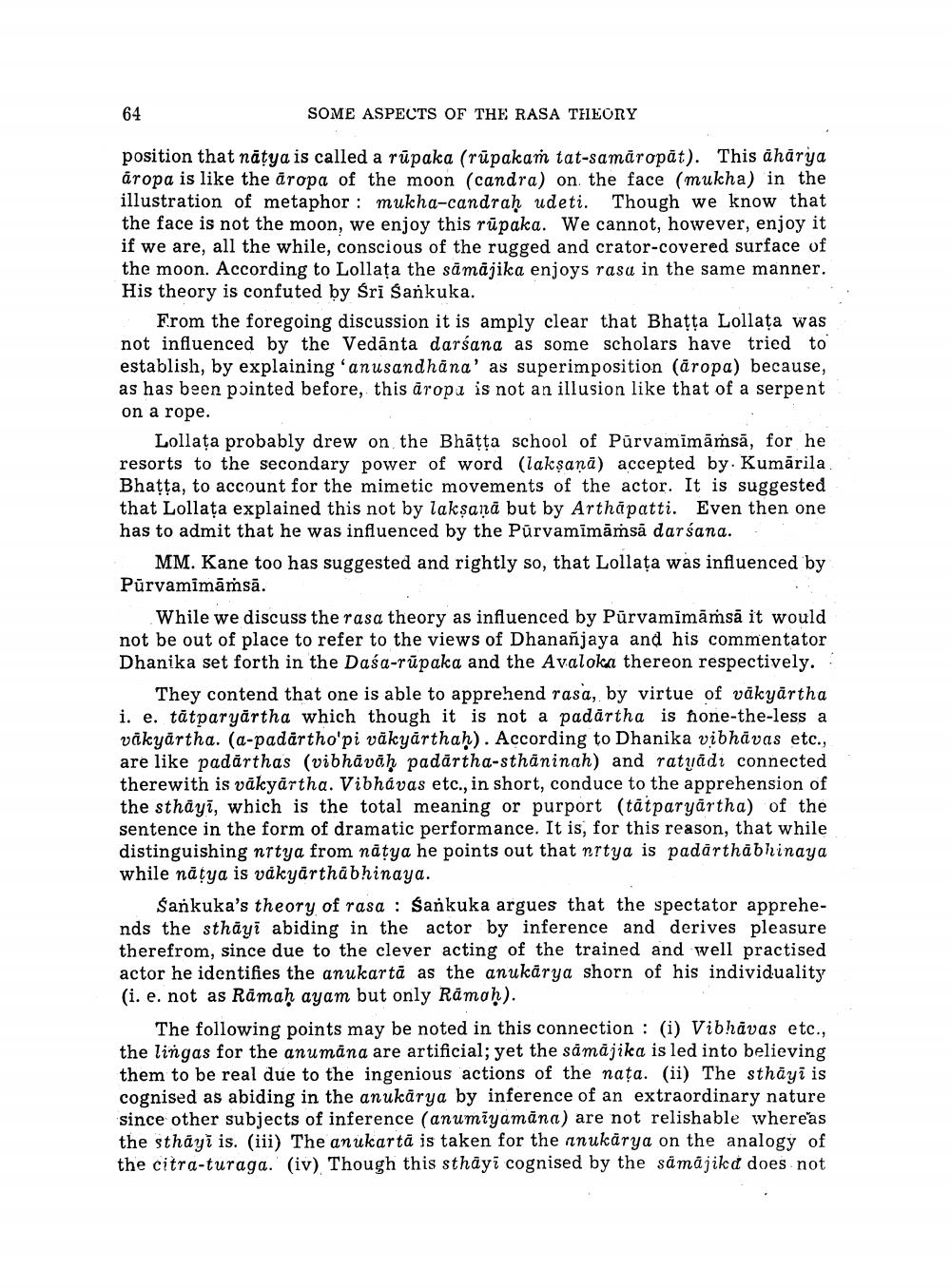________________
64
SOME ASPECTS OF THE RASA THEORY
position that natya is called a rūpaka (rūpakan tat-samāropāt). This ahārya áropa is like the āropa of the moon (candra) on the face (mukha) in the illustration of metaphor : mukha-candrah udeti. Though we know that the face is not the moon, we enjoy this rūpaka. We cannot, however, enjoy it if we are, all the while, conscious of the rugged and crator-covered surface of the moon. According to Lollata the sāmājika enjoys rasa in the same manner. His theory is confuted by Sri Sankuka.
From the foregoing discussion it is amply clear that Bhatta Lollața was not influenced by the Vedānta darśana as some scholars have tried to establish, by explaining anusandhana' as superimposition (āropa) because, as has been pointed before, this āropu is not an illusion like that of a serpent on a rope.
Lollața probably drew on the Bhāțța school of Pūrvamīmāṁsā, for he resorts to the secondary power of word (iakşaņā) accepted by. Kumārila. Bhatta, to account for the mimetic movements of the actor. It is suggested that Lollaţa explained this not by laksana but by Arthāpatti. Even then one has to admit that he was influenced by the Pūrvamīmāṁsā darśana..
MM. Kane too has suggested and rightly so, that Lollața was influenced by Pūrvamimāṁsā.
While we discuss the rasa theory as influenced by Pūrvamimāṁsā it would not be out of place to refer to the views of Dhananjaya and his commentator Dhanika set forth in the Dasa-rūpaka and the Avaloka thereon respectively. :
They contend that one is able to apprehend rasa, by virtue of väkyārtha i. e. tātparyārtha which though it is not a padārtha is none-the-less a vākyārtha. (a-padartho'pi vākyarthah). According to Dhanika vibhāvas etc., are like padārthas (vibhāvõh padārtha-sthāninah) and ratyādi connected therewith is vākyārtha. Vibhávas etc., in short, conduce to the apprehension of the sthāyī, which is the total meaning or purport (tātparyartha) of the sentence in the form of dramatic performance. It is, for this reason, that while distinguishing nrtya from nätya he points out that nrtya is padārthābhinaya while nāțya is vákyarthābhinaya.
Sankuka's theory of rasa : Sankuka argues that the spectator apprehends the sthāyī abiding in the actor by inference and derives pleasure therefrom, since due to the clever acting of the trained and well practised actor he identifies the anukartā as the anukārya shorn of his individuality (i. e. not as Ramah ayam but only Rámoh).
The following points may be noted in this connection : (i) Vibhāvas etc., the lingas for the anumäna are artificial; yet the samăjika is led into believing them to be real due to the ingenious actions of the nața. (ii) The sthāyi is cognised as abiding in the anukārya by inference of an extraordinary nature since other subjects of inference (anumiyamāna) are not relishable whereas the sthāyī is. (iii) The anukartä is taken for the nnukärya on the analogy of the citra-turaga. (iv). Though this sthāyi cognised by the sámåjikd does not




